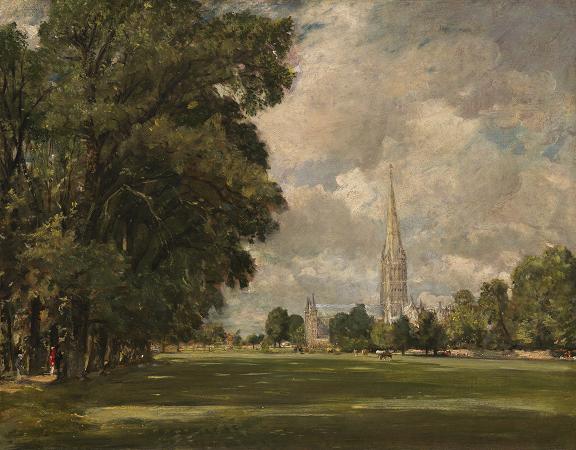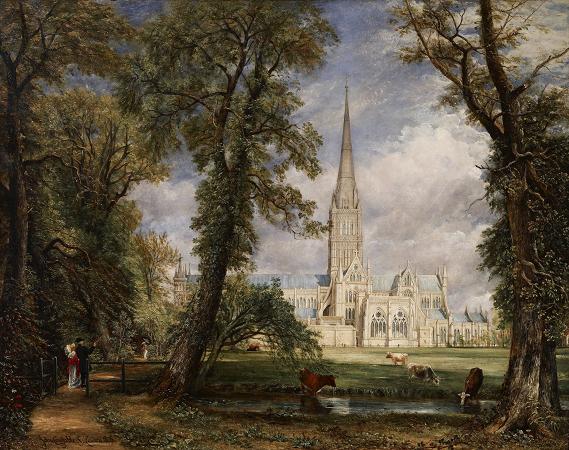Salisbury Cathedral. Salisbury Cathedral, formally known as the Cathedral Church of the Blessed Virgin Mary, is an Anglican cathedral in Salisbury, England. The cathedral is regarded as one of the leading examples of Early English architecture: its main body was completed in 38 years, from 1220 to 1258. Since 1549, the cathedral has had the tallest church spire in the United Kingdom, at 404 feet. Visitors can take the Tower Tour, in which the interior of the hollow spire, with its ancient wooden scaffolding, can be viewed. The cathedral has the largest cloister and the largest cathedral close in Britain at 80 acres. It contains a clock which is among the oldest working examples in the world, and has the best surviving of the four original copies of Magna Carta. In 2008, the cathedral celebrated the 750th anniversary of its consecration. The cathedral is the mother church of the Diocese of Salisbury and is the seat of the Bishop of Salisbury, currently Nick Holtam. As a response to deteriorating relations between the clergy and the military at Old Sarum Cathedral, the decision was taken to re-site the cathedral, with the seat of the bishopric being moved to New Sarum, or Salisbury. The move occurred during the tenure of Richard Poore, a rich man who gave the land on which the new cathedral was built. Construction was paid for by donations, principally from the canons and vicars of southeast England, who were asked to contribute a fixed annual sum until the building was completed. A legend tells that the Bishop of Old Sarum shot an arrow in the direction he would build the cathedral; the arrow hit a deer, which died in the place where Salisbury Cathedral is now. The cathedral crossing, Old Sarum, and Stonehenge are reputed to be aligned on a ley line, although Clive L. N. Ruggles asserts that the site, on marshland, was chosen because a preferred site several miles to the west could not be obtained. The foundation stone was laid on 28 April 1220. Much of the freestone for the cathedral came from the Teffont Evias Quarry. As a result of the high water table on the new site, the cathedral was built on foundations only 4 feet deep, and by 1258 the nave, transepts, and choir were complete. The only major sections begun later were the cloisters, added in 1240, the chapter house in 1263, the tower and spire, which at 404 feet dominated the skyline from 1320. Because most of the cathedral was built in only 38 years, it has a single consistent architectural style, Early English Gothic. In total, 70,000 tons of stone, 3,000 tons of timber and 450 tons of lead were used in the construction of the cathedral. Although the spire is the cathedral's most impressive feature, it has proved troublesome. Together with the tower, it added 6,397 tons to the weight of the building. Without the addition of buttresses, bracing arches and anchor irons over the succeeding centuries, it would have suffered the fate of spires on other great ecclesiastical buildings and fallen down; instead, Salisbury became the tallest church spire in the country on the collapse at Lincoln in 1549. The large supporting pillars at the corners of the spire are seen to bend inwards under the stress. The addition of reinforcing tie-beams above the crossing, designed by Christopher Wren in 1668, halted further deformation. The beams were hidden by a false ceiling installed below the lantern stage of the tower. Significant changes to the cathedral were made by the architect James Wyatt in 1790, including the replacement of the original rood screen and demolition of a bell tower which stood about 320 feet northwest of the main building. Salisbury is one of only three English cathedrals to lack a ring of bells, the others being Norwich Cathedral and Ely Cathedral. However, its medieval clock does strike the time with bells every 15 minutes. In February 2016, the cathedral chapter placed Sophie Ryder's sculpture The Kiss straddling a path on the grounds where it was to remain until July. After only a few days, the work had to be moved, as pedestrians kept bumping into it while texting.
more...











